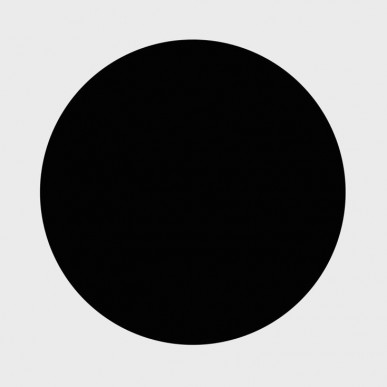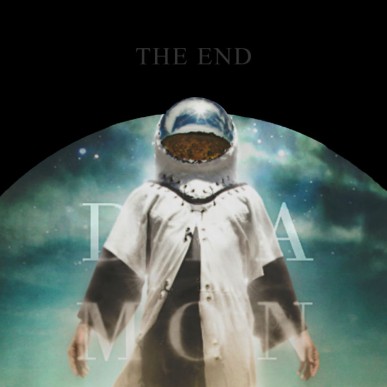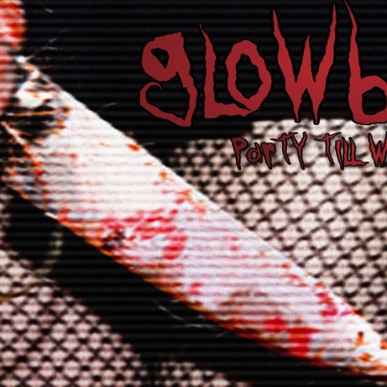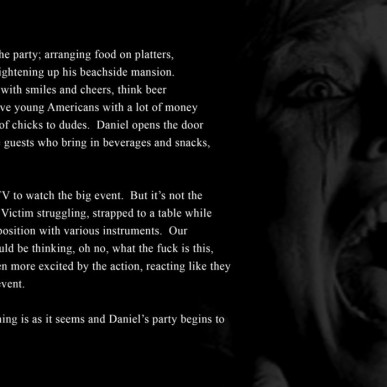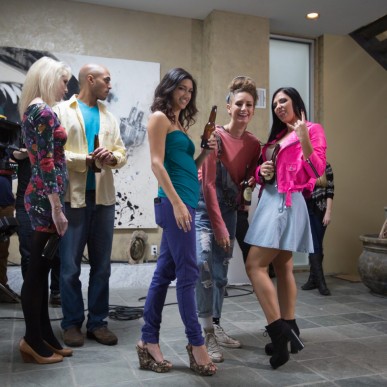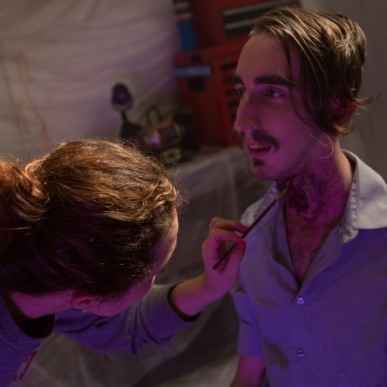
As much as the discovery of new filmmaking talent has always fuelled the fires of DN Towers, the articles where we catch up with the work of previous guests will always hold a fond place in our hearts as it means that the talent which initially impressed us has been able to sustain into a career – not to mention the horn blowing potential of having identified them as someone to watch. So is the case with Director Jason Roberts who first grabbed our attention back in 2010 with the effective tagline ‘One cash register, two robbers, and $3.50’ that proceeded his short Leader of the Pack. Jason recently got in touch to let us know about the new, and vastly different, music videos he’d created for Diamondstein’s Nat Sherman Arpeggiator and Glowbug’s Death of the Party respectively. Well, not wanting to play favourites we decided to double Jason’s workload by having him explain how he brought each of these concepts to music video fruition.
Nat Sherman Arpeggiator is a very abstract piece in both its form and delivery, how did the concept first come into being?
I was originally inspired by the work of Alberto Seveso who composited faces into plumes of ink in water. I have an archive of photographs by artists, typically manipulated in Photoshop, which I would love to figure out incorporating motion in to. This came before Ben Majoy, AKA Diamondstein, came to me about the video. That was immediately what popped into my head. The song was a long one and evolves so well so I knew I would need to fill the time with complimentary visuals. Evolution/transformation was always a part of the conversation. I dipped into that inspiration archive and started to draw from it images that I not only always wanted to “move” but also which would fit the progression. I threw in images and techniques I’ve wanted to experiment for sometime – the cloth in reverse, a primal dance featuring close-ups of the human form – and wrote the treatment after long stints of pacing in my room listening to the tune over and over. But even after that was set the ideas didn’t stop flowing. For instance, inverting the background to black and the dancer from an alien-like black figure to something more natural was not a budgetary move but a conscious one. I found a set of photographs by Fabio Selvatici that blew my mind and changed my thoughts on the overall look right there. That in itself was a blessing in disguise because covering a person in black paint probably would have been a huge hassle I am so happy to have not committed to. The mask on the other hand was something that came about after we shot. When Ben showed it to me I HAD to have it somewhere in the video. The original treatment was for the video to loop, but that mask was too good not to be incorporates so we changed the ending.
A gap exists between your pitched treatment and the final film. How much did the technical challenges of the treatment dictate the ultimate form and content of finished piece?
Early on when experimenting with VFX, I realized there was only so much I was going to be able to pull off in a reasonable amount of time. It because pretty clear that in order to achieve the effects, I would need to employ Cinema 4D or another 3D program to have proper control. My Director of Photography Patrick Lawler and I talked about learning the program together, and I went so far as to try a few tutorials but it soon sunk in that the amount of time it would take just to learn the program was not conducive to the project’s timeline (which mind you was indefinite, but not something I would want to be chipping away at for two years). But I think I managed to stay in the same ball park with the original treatment.
- Nat Sherman Arpeggiator Treatment 1/12
- Nat Sherman Arpeggiator Treatment 2/12
- Nat Sherman Arpeggiator Treatment 3/12
- Nat Sherman Arpeggiator Treatment 4/12
- Nat Sherman Arpeggiator Treatment 5/12
- Nat Sherman Arpeggiator Treatment 6/12
- Nat Sherman Arpeggiator Treatment 7/12
- Nat Sherman Arpeggiator Treatment 8/12
- Nat Sherman Arpeggiator Treatment 9/12
- Nat Sherman Arpeggiator Treatment 10/12
- Nat Sherman Arpeggiator Treatment 11/12
- Nat Sherman Arpeggiator Treatment 12/12
Music videos with this budget size allow me to experiment and grow as an artist. I sort of build creative flexibility into my pitch as compensation for my time. The money often goes to crew and resources. But it’s been proven that I’ll work my ass off to deliver the best product possible. It’s like basic training for the real world.
How did you convey the difference between the pitch and final film to Diamondstein whilst maintaining trust in your ability to ultimately deliver something he wanted?
Ben Majoy, the musician behind the diamond mask, is a good friend and former colleague of mine in the ad world. It was a blessing to have him by and on my side throughout because he understood the process. Plus this was made for really no money. I tried to use the little money we had to pay the crew and get the necessary equipment, taking a few hits financially myself. Being paid was never the point, but I suppose that allowed me some leverage to say, “due to limitations here and there, we might not be able to pull off what I originally intended, but this is what we CAN do.” I kept Ben a part of the conversation as much as I could along the way. In many ways it was to keep me in check. I have a penchant for locking myself away from the world and working on a project until, in my eyes, it’s the best it can be not allowing objective eyes to see works in progress. I had to break that habit with this one because post took so long. So I would send Ben progress reports and directions I was exploring for visual effects just to get him excited about where it was going. He was so great about giving feed back and incredibly understanding about how the direction was changing. We had our creative battles, but he really helped push this thing to what it is. If I didn’t have that outside eye, Patrick of course being another one, I don’t think it would have turned out this good. I was looking through some old edits and I am so glad those guys made me keep searching for the right aesthetic. There were some things I was fighting for that, in retrospect, were not nearly as good! I think that throughout I was trying to keep an open line of communication and a collaborative experience.
Regardless of the original plan Nat Sherman Arpeggiator still hosts an impressive mix of visuals. What was your process on set to minimise the VFX pain?
I made a shot list for the VFX sequence, but kept the dance part loose so we had a series of shots where we discussed what was going to be happening. Most of them played out on a wider lens and the Red Dragon allowed us the resolution to punch in if need be. When we were shooting Ana’s dance I let Patrick run wild and find the shots I was looking for. I was interested in close ups of her muscles contorting, getting close and personal with this organic machine and breaking down how it worked through our camera language. A lot of the angles and movements he was capturing looked so great, especially in slow motion, so I couldn’t help but consider using them for the VFX sequence. I wasn’t sure how I would incorporate them, for better or for worse, but I knew we had something more to work with. The sequence of her being lifted up by the cloud to her twirling around in space all came from those moments. So it was a combination of deliberate set-ups and just feeling it out. It made post more of a headache, but that sequence feels a lot more organic as a result.
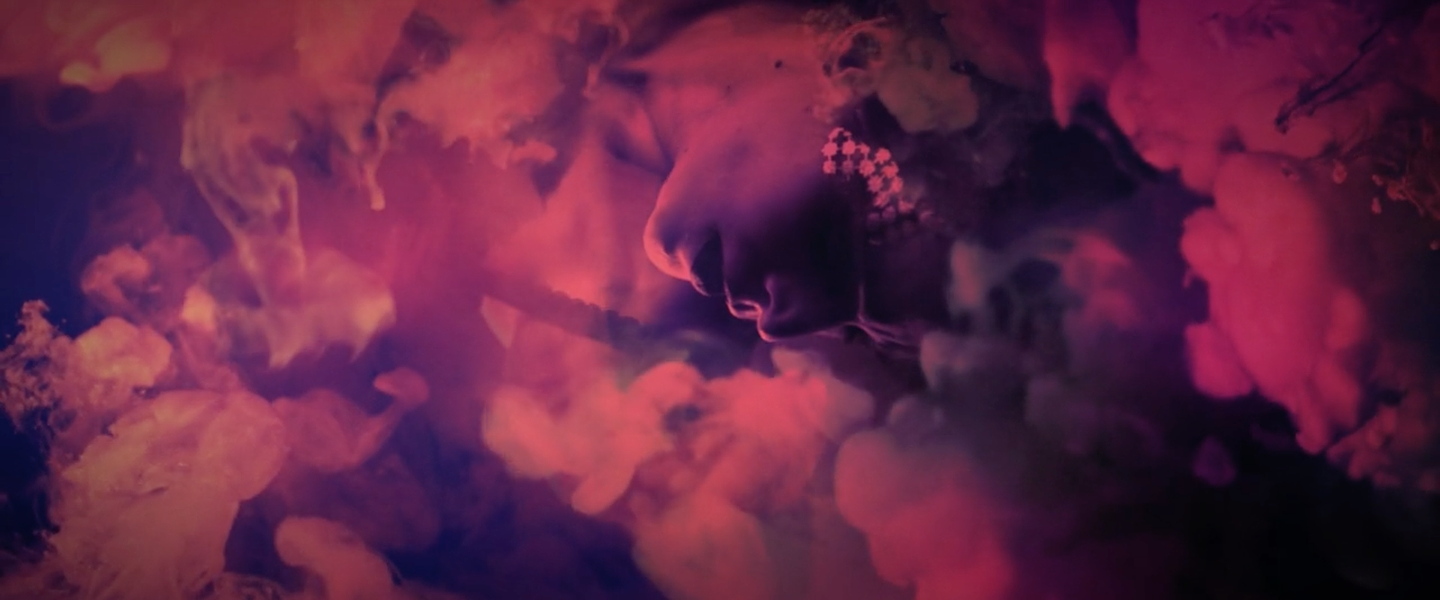
The early muted styling almost starves the eye, making it hungry for the burst of colour which arrives later in the film. We’re you concerned about holding the audience’s visual interest until that point given the limited palette?
It was certainly a concern, but the song has a natural progression so I was able to base the visuals around that. Holding back on color, for instance, was not so much of a concern for me. It was that it pretty much was revealed half way through the piece and I had no idea how to keep people’s attention after that! The last thing I wanted was Ana twirling around in colorful clouds for the remaining two minutes while the first half progressed so naturally. But then I saw that mask. That wonderfully creepy mask. That was the final piece of the puzzle. Patrick and I went back to the studio with Ana and grabbed the shots where her face is burning off and we shot all of the mask plates in our apartment. I also loved the idea of the video directly tying in to Ben’s stage performance as well. My work in advertising has fostered an affinity for branding in me!
What steps did you take the footage through to arrive at those fabulous images?
I cut in Adobe Premiere CC and do everything else in After Effects. I went through a lot of experiments for the over-all look. For instance, originally I wanted Ana’s face to break apart in pieces. I went down some roads with that in mind, but never quite got the look I was going for. Same goes for other shots where her skin was supposed to crack. I made cracks in Photoshop and was using mesh warps and 3D camera tracking to try and map them to her body, but not only was it time consuming, I just couldn’t nail the look. It became pretty clear that most of the shots I wanted to do required the likes of Maya or Cinema 4D, programs which I have not dug into. It would have been a year before I could get the bearings to accomplish it, so I opted for a more simple, elegant approach over-all. And it’s a good thing I did. What we see now is much more elegant than what I originally envisioned.
When the cloud first explodes from her back, you’ll notice particles raining down on her. These are in face 2D texture layers that I manipulated in 3D space, supplemented with blending modes, levels, etc. In fact, believe it or not, those same texture layers are on ALL of the cloud shots. For a good long while I was making an effort to keep them around, even once the colors really began to shift. The grainy was something I really liked at first, but couldn’t win over anyone else who saw it. The dirty aesthetic ultimately contrasted the action surrounding it and to avoid starting from scratch I kept manipulating the texture layers, trying different blending modes and other techniques, until I landed on Darken mode and blurring the living hell out of the texture. It seemed like a happy accident, but I figure I would have landed on that eventually. It was a result of continuing to explore new avenues. Never leave stones unturned! You’ll never know what treasure you’ll find underneath.
DoP Patrick Lawler’s contribution to the project extended far beyond the shoot itself. How did he augment the VFX elements you created for the film?
I’ll let Patrick take over for this one!
“Originally Jason had expressed an interest in using a combination of ink drop elements and particle effects to tell this transformation story. Lighting everything low-key helped make the elements we added in post look more realistic. As far as the VFX are concerned I was mostly involved from a critiquing and idea-bouncing standpoint. Once Jason was 95% finished with the video, he had to go out of town, and I took over the polishing of the video. I went through and cleaned up a bunch of masks, stabilized some footage, color corrected everything, and added numerous foreground layers to things. I also made the title sequence. I’m finding it to be true more and more that the more you can throw on top of a VFX shot the more a part of the same world the separate elements feel, so I added multiple layers of color correction, gradient filters, textures, overlays, film burns, or film grain, etc. and I think it added a lot to the overall look of the video.”
Diamondstein’s Nat Sherman Arpeggiator and Glowbug’s Death of the Party are pretty much polar opposites of each other, but you worked on them almost simultaneously. Was there a beneficial ‘palette cleansing’ effect of bouncing between the two?
Well I’m not going to lie, I felt a little guilty abandoning Diamondstein for Glowbug. I felt like I was cheating on Ben a little! Truth be told, Glowbug was in the works in one way or another for almost a year. There were a number of decisions along the way to push and push the project back until we had the resources needed to pull it off the way we intended. From what I remember, Daniel more or less gave the green light to move not long after Diamondstein’s principle photography, in early October 2014. We shot Death of the Party that December and leading up to the day I was able to give equal attention to both projects, but as soon as we wrapped shooting Death of the Party took all of it.
Before that happened, though, Diamondstein was beginning to overwhelm me. The edit was so hard to piece together – especially stringing out the VFX sequence without being able to see anything finished. Having never worked with visual effects at that capacity, it was a struggle to imagine how the shots would turn out and build a pace and language to the edit around it. I think I got the first half of the video cut and a few moments that I knew I wanted in the second half (after the cloud explodes from her back) but all moments in between were a terrifying mystery to me. With Glowbug to distract me for a few months I was able to reset my brain to approach Diamonstein at a new angle.
Glowbug also taught me something. Show people works in progress! I live with Patrick, but didn’t let him see a frame of the rough cut! I guess all of my time spent in advertising, where often times you need to show what you consider a final cut to someone (which they will tear to shreds and leave you to pick up the pieces), I was afraid to show anything I deemed unfinished. I was concerned that no one would think it’s working. The truth is, it probably isn’t and that’s ok! You just need to polish and polish and polish until it shines and it’s ok to get a little help in doing so! Anyways, that lesson was invaluable, because when it came to pick up Diamondstein again, Patrick was CRUCIAL in shaping the VFX sequence edit. He was able to look at the raw footage in a different way, and choose shots with effect ideas in mind that I was not even in the ballpark of thinking about. That was a huge moment, because I finally started to see the piece as a whole and it gave me the confidence to move forward.
I presuming that the term ’snuff video party’ doesn’t tend to come up during pitch meetings often. How did the gruesome treatment for Death of the Party come about?
You must be going to the wrong meetings! Funnily enough Daniel Anderson, AKA Glowbug, came to me with the idea! When we first started chatting about collaborating on another video, he mentioned his love for horror and outlandish violence. I loved the idea of taking a pop song and contrasting it with extreme imagery. It’s fascinating! Not to mention, Glowbug has elements of that very contrast in his songs, and Death of the Party is the perfect example. It sounds like a summer pop anthem until it hits the chorus and Daniel just tears the mic apart with his scream. If this was your introduction to him, you would never see it coming, and that’s what I love about his music; there’s always an element of surprise. He’s always taking certain genres and tropes and messing with them, making things sounds intentionally off. It’s wonderful, wonderful stuff! That mindset is something I’ve always been attracted to and wanted to incorporate more into my work, so I really ran with it from there.
- Party Till We Die Treatment 1/23
- Party Till We Die Treatment 2/23
- Party Till We Die Treatment 3/23
- Party Till We Die Treatment 4/23
- Party Till We Die Treatment 5/23
- Party Till We Die Treatment 6/23
- Party Till We Die Treatment 7/23
- Party Till We Die Treatment 8/23
- Party Till We Die Treatment 9/23
- Party Till We Die Treatment 10/23
- Party Till We Die Treatment 11/23
- Party Till We Die Treatment 12/23
- Party Till We Die Treatment 13/23
- Party Till We Die Treatment 14/23
- Party Till We Die Treatment 15/23
- Party Till We Die Treatment 16/23
- Party Till We Die Treatment 17/23
- Party Till We Die Treatment 18/23
- Party Till We Die Treatment 19/23
- Party Till We Die Treatment 20/23
- Party Till We Die Treatment 21/23
- Party Till We Die Treatment 22/23
- Party Till We Die Treatment 23/23
Were there any issues in casting for such a sadistic piece? How did you direct them to reach the correct brutal performance levels?
None at all!! Daniel gathered his friends and some fellow musicians to fill the roles. The only tricky thing was finding our lead actress. Daniel was very involved with the process from start to finish, something I am very grateful for, and he insisted on getting name talent to play opposite him. We were thinking of taking a more traditional approach in casting a recognizable actress, but later he suggested just going for it and considering a porn star! So he and our producer Mckenzie Goodwin reached out to a bunch and it came down to Dani Daniels. She loved the idea and wanted to be on board. She was a real sweetheart and so great to work with! The only downside to it all was she only had one day with us and there was no time for rehearsals. That definitely affected the deviation from my shot-list and storyboards. I also had that in mind when writing the script. There were a lot of ideas surrounding how Dani and Daniel interacted that I left on the table knowing that I had so much to cover in so little time. I’m still baffled that we were able to get what we did in one day.
When directing the party watching television, I played it out as if they were watching a football game. I would shout out a make believe play, like the receiving team running a ball back from kick off, or an interception, and have them react to that. With such a quick shooting schedule I left it open to improvisation. I was lucky because all of the extras are artists in their own ways, so they all brought very good energy and a lot of great ideas along with them. We also had two Red Dragons, one on a Steadicam and another on a Ronin, at all times. That lent us the luxury of a lot of coverage.
Even though it wasn’t necessarily implemented on the day I know that thorough prep is key to your process. What changed from your pre-production expectations and how did you pivot in reaction to those changes?
I wanted to pack too much into the video, and didn’t have the luxury of time, or as mentioned rehearsals to pull it off properly. I was my own AD on set, so keeping the day moving was also on my shoulders, and I had to streamline a lot of what I wanted to do. We got lucky at the very last minute when Patrick brought in not one, but TWO Steadicam operators (well the 2nd was a Ronin, but still..). Orlando Duguay and Tyler Cushing were a tremendous help! As soon as I caught wind of that I had some conflicting thoughts. For one, we’re gonna get SOOOO much coverage to work with! But, I won’t be able to have eyes on both cameras at the same time, so I intentionally loosened the shot-list up and sort of made way for more improv in front and behind the camera.
How much did VHS aesthetic of the snuff segments help with regards to stretching the budget and pulling off the torture clips convincingly?
Not as much as you would think. The VHS look was always deliberate from the get-go, and not necessarily a way to hide some of the effects. Our make up SFX team Sydney Hunt and Sioux Sinclair did a phenomenal job working with so little. We were conscious of getting the most bang for our buck. Daniel Anderson and I decided to have two big set pieces, the head smash and gutting our buddy Dan Finfer. Most of the budget went to those effects, but the others were meant to be as cost effective as possible. But to be honest, we could have removed the VHS effects altogether and the work they did would still be convincing. I commend Sydney and Sioux for their ingenuity.
Now that this unlikely pair of projects are complete, where will your next film take us?
You know, I’m not so sure just yet. I have a few ideas rattling around in my brain. I’ll say this much, I would very much like to get back to narrative story telling, be it another short or a feature. Storytelling is where my heart is and why I am doing this for a career in the first place. But that said, whatever it ends up being, I know I can do better. I’ll do everything I can to prove that.



